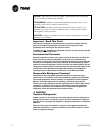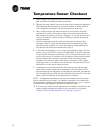
2 RLC-SVD03A-EN
Important - Read This First!
This manual is intended for experienced service personnel familiar with the
proper use of electrical diagnostic instruments and all personal safety
procedures when working on live electrical circuits.
This Manual is not intended for individuals who have not been properly trained
in handling live electrical circuits.
Environmental Concerns!
Scientific research has shown that certain man-made chemicals can affect the
earth’s naturally occurring stratospheric ozone layer when released to the
atmosphere. In particular, several of the identified chemicals that may affect the
ozone layer are refrigerants that contain Chlorine, Fluorine and Carbon (CFCs)
and those containing Hydrogen, Chlorine, Fluorine and Carbon (HCFCs). Not all
refrigerants containing these compounds have the same potential impact to the
environment. Trane advocates the responsible handling of all refrigerants—
including industry replacements for CFCs such as and HCFCs and HFCs.
Responsible Refrigerant Practices!
Trane believes that responsible refrigerant practices are important to the
environment, our customers, and the air conditioning industry. All technicians
who handle refrigerants must be certified. The Federal Clean Air Act (Section
608) sets forth the requirements for handling, reclaiming, recovering and
recycling of certain refrigerants and the equipment that is used in these service
procedures. In addition, some states or municipalities may have additional
requirements that must also be adhered to for responsible management of
refrigerants. Know the applicable laws and follow them.
ƽ WARNING
Contains Refrigerant!
System contains oil and refrigerant under high pressure. Recover refrigerant to
relieve pressure before opening the system. See unit nameplate for refrigerant
type. Do not use non-approved refrigerants, refrigerant substitutes, or refrigerant
additives.
Failure to follow proper procedures or the use of non-approved refrigerants,
refrigerant substitutes, or refrigerant additives could result in death or serious
injury or equipment damage.
NOTICE: Warnings and Cautions appear at appropriate sections through-
out this literature. Read these carefully.
ƽ WARNING: Indicates a potentially hazardous situation which, if not
avoided, could result in death or serious injury.
ƽ CAUTION: Indicates a potentially hazardous situation which, if not
avoided, may result in minor or moderate injury. It may also be used to
alert against unsafe practices.
CAUTION: Indicates a situation that may result in equipment or property-
damage only accidents.


















